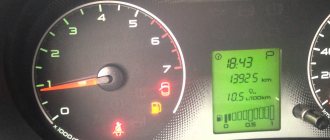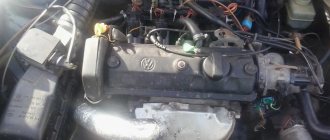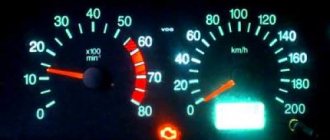When cold, the speed floats , with increased fuel supply to the cylinders for quick warm-up, when there is a leak of unaccounted air in the intake manifold, in case of problems with sensors (oxygen, throttle position, mass air flow, engine temperature sensor), low fuel pressure, faulty regulator idle speed and a number of others, depending on the type of engine. If the sensors are faulty, the ECU issues incorrect commands, due to which the engine speed may fluctuate when cold and become high or low.
Most of the problems, regardless of whether it is an injector, a carburetor or a diesel engine, are the same, but there are also some peculiarities that may be the reason why there are drops in speed when cold, and often when hot too. In short, all the reasons why the engine does not maintain speed when cold are displayed in the table, but if you need more specific recommendations for eliminating jumps in the speed of a cold engine, read the article and the comments to it, where car owners often share their experience.
| Cause of malfunction | Faulty node | Necessary actions |
| Injector | ||
| Atmospheric air suction |
| Check all the listed parts by pinching the hoses, using a compressor (compressed air), or a smoke generator |
| Engine sensor malfunction |
| Perform diagnostics of the listed sensors. If necessary, replace them with new ones. |
| Insufficient fuel to maintain engine speed |
| Perform diagnostics, cleaning or replacement of injectors. Fuel up with better quality gasoline. |
| Problems with the ignition system |
| Check the operation of the listed elements. The spark plugs can be cleaned or replaced. Wires and coils are replaced with new ones. |
| Compression reduction |
| Perform a compression check in the cylinders, repair measures depending on the diagnosis |
| Low fuel pressure |
| You need to check the fuel pump, fuel filters (fine filters and mesh), and pressure regulator (the mesh may become clogged). |
| Carburetor | ||
| Not enough fuel or air | Incorrectly adjusted carburetor or clogged jets | Adjust the carburetor, select the optimal idle speed, and clean the jets. |
| Excess air intake | Dirty throttle valve | Clean the damper, check its drive |
| Aperture malfunction | Check and, if necessary, replace the unit | |
| Carburetor gasket | Replacing the node with a new one | |
| Solenoid valve | Diagnostics and, if necessary, valve replacement | |
| Diesel engines | ||
| Insufficient fuel pressure |
|
|
| Incorrect commands from the electronic control unit |
|
|
| Excessive exhaust gases in the intake manifold | EGR system | Check the EGR valve and the operation of the entire system. Correct it or properly suppress it. |
| Air in the fuel line |
| Check the listed elements, if there is a diesel leak, restore the seal, replace the fuel filter. |
Possible reasons
If the speed fluctuates when cold, this is not due to a malfunction of one particular sensor or mechanism. If the internal combustion engine is unstable, you need to diagnose each system in turn:
- Intake tract. Air leaks in the intake system are the most common cause of floating speed when cold.
- Fuel system. We look at the filter, pump and injectors. The latter should be given special attention, especially if it is a diesel engine. Yes, the car starts and pulls up any incline, but when it’s cold, the engine won’t hold speed.
- Sensors Check the mass air flow sensor, air sensing sensor, lambda probe, and idle air control valve. They may be excessively dirty, or may not work due to a short circuit or poor contact.
- Cylinder-piston group. If the compression measurement showed disappointing results, the reason is precisely the CPG.
Is it possible to diagnose DPKV and DSA?
A breakdown of the DPKV and DSA (Hall sensor) is indicated by the Check Engine indicator that lights up on the car’s dashboard. Testing these devices is only possible using special instruments (oscilloscopes). You can first check the integrity of the wiring; if it is broken, the damage should be repaired.
- The DPKV sensor is installed on a bracket located in close proximity to the generator drive pulley.
- The DSA is located on the speedometer drive mechanism of the gearbox.
Could it be due to the battery?
Let's dispel all the myths right away.
No matter how “dead” the battery is, it will not cause the speed to jump after a cold start. The starter may turn slowly, but the engine will run normally after starting.
It's another matter if the battery warning light flashes at idle. At the same time, the instrument panel lights flicker, the lights strobe, and the car’s revs fluctuate. Why is this happening? A faulty generator cannot provide normal voltage for the operation of all engine systems. In this case, you can hear a characteristic noise or whistle from under the hood. Usually brushes, voltage regulator, bearings and diode bridge fail.
The conclusion is this: if the revs fluctuate when starting from cold, and the battery light is on, look towards the generator.
How does this happen
If the car is running normally, all you need to do is start it and wait until the engine warms up to the optimal temperature. The tachometer indicator at this moment is at 2-2.5 thousand rpm, and then gradually drops to about 800 rpm as the power unit warms up.
But when there are problems, the idle speed jumps and changes sharply. The range of revolutions difference on the tachometer can be significant, up to 1.5 thousand revolutions. The car seems to live its own life. After some time, this phenomenon stops. But the next time the ignition is turned on, everything repeats.
Air leak in intake
These are cracks in the intake manifold, hoses, leaky connection of pipes or breakdowns in the vacuum hose of the brake booster. Often air gets trapped at the junction of the throttle valve and the manifold. Air that is not taken into account by the sensors enters the system, which changes the composition of the fuel mixture.
Broken pipe
The control unit cannot adjust the mixture, because “on paper” everything is clean - exactly as much oxygen as needed has passed through the sensors. On some cars, the ECU still tries to correct the injector corrections, but cold engine operation still remains unstable. By the way, as it warms up the problem may disappear. Why? As the temperature increases, engine parts expand, and if air is sucked in, it is only slightly, without causing problems when the car operates.
If the speed fluctuates on a cold engine, the problem may be hidden by a “sagging” intake manifold gasket, which is completely impossible to notice with your eyes. Visually there are no cracks, there is nowhere for air to get in, and even when hot, the speed levels out. Do not rush to open the manifold - air leaks can be checked with a smoke generator.
Smoke generator
Such a device is available at many service stations. The technician runs a smoke generator into the intake system and controls where the leak is coming from. This is a quick and accurate way to determine leakage, and most importantly, it is absolutely safe for the engine.
Cleanliness of the damper assembly
The throttle valve assembly is diagnosed by visual inspection for contamination. Clean the part with cotton swabs and a toothbrush moistened with a cleaning solution. For ease of work, the device is dismantled. After cleaning, it is recommended to blow out all channels and pipes of the unit with compressed air using a tire inflator.
To clean the part, it must be dismantled.
Attention! It is recommended that the channel responsible for removing gases from the crankcase be completely filled with a cleaning solution before purging - the diameter of the element is very small and there is no other way to access it.
Low fuel pressure
We begin the check with the elementary - fuel filters. There are two of them - coarse and fine cleaning. The first is located together with the pump (usually in the tank), the second is under the bottom or in the engine compartment. The coarse filter should be changed every 100 thousand kilometers, and the fine filter once every 30 thousand. Replacement may be required earlier if bad fuel was accidentally filled in.
If after replacing the filters the car still does not hold speed, starts poorly when cold and may stall, check the fuel pressure regulator.
Fuel pressure control
On a car with high mileage, the valve membrane is damaged, causing the engine to not receive the required amount of fuel. Fortunately, the part is inexpensive and can be changed quickly.
If diagnostics show that the old regulator maintains fuel pressure, the pump may be the cause of all the troubles. The blades, bearing or the electric motor itself may be faulty.
Popular brands:
Audi RS 7, Mazda CX–7, Skoda Octavia
Idle speed control
The regulator tends to become dirty at a distance of more than 100 thousand kilometers. Because of this, the regulator rod begins to jam, and sometimes jams in one position. The speed fluctuates when cold, sometimes even when hot. At the same time, the motor rotates without problems under load.
Idle speed control
There are two options for solving the problem - disassemble and clean the old regulator, or replace the IAC with a new one. It is important to know that Chinese substitutes quickly fail, so try to buy original IACs or analogues from trusted manufacturers.
How can I check the regulator and flow meter?
If the speed begins to fluctuate with enviable regularity, it is better to start diagnostics by checking the air-fuel mixture flow sensor. The following symptoms indicate a malfunction of the air flow sensor:
- A cold motor “floats” and there are interruptions.
- The engine does not start the first or even the second time, sometimes it does not start at all.
- Fuel consumption exceeds all permissible limits.
How can you determine when it’s time for the sensor to retire? It’s very simple - use a regular tester. It should show 1 V if the MAF is ok. Otherwise, you will need to make a replacement.
We've sorted out the flow meter - now let's talk about the regulator. The speed in your engine may fluctuate due to the fact that the idle speed regulator has failed. It is responsible for quickly increasing or decreasing the fuel supply, using a rod with a needle for this purpose. Among the key malfunctions of the regulator are:
- Quite unstable, “ragged” operation of a cold engine when idling.
- In neutral, the engine suddenly turns off.
- Unexpected changes in speed even when the engine is well warmed up.
- Lack of normal power growth when the engine is already running.
Power (more precisely, engine speed) drops when several consumers come into operation at once. Even ordinary headlights can make noise. If the above symptoms are observed, the regulator will need to be replaced.
Sensors
We inspect all sensors that may affect engine idle operation. These are the sensors:
- mass fuel consumption;
- throttle position;
- internal combustion engine temperatures;
- absolute air pressure;
- intake air temperature.
The engine ECU receives information from the sensors based on their voltage, which varies under different conditions. If the contact is bad or damaged, the data will be incorrect.
The ECU will incorrectly adjust the mixture or go into “emergency mode” - try to at least somehow maintain the speed, just so as not to stall the engine. It’s not necessarily a matter of wiring - despite the simplicity of the device, the sensor itself can also become unusable. There are frequent cases when owners installed sensors that were not suitable for a specific internal combustion engine or sensors from unknown manufacturers, which is why the speed problem did not go away.
Only after proper diagnostics will it become clear which sensor is faulty and requires replacement.
Do-it-yourself troubleshooting
Many faults from the above list can be eliminated yourself in a few minutes. It will take much more time to identify.
Diagnostics of mass air flow sensor and IAC
The mass air flow sensor and idle air control act as regulators of air supply to the combustion chamber.
We have already written in more detail about diagnosing the air flow sensor; you will need a multimeter!
Failure of these sensors will lead to an increase in fuel consumption, and a broken rod will affect the speedometer needle; it will remain motionless until the problem is fixed.
Checking the functionality of the idle air regulator
Checking the performance of the mass air flow sensor
If any malfunctions are detected, the idle air regulator must be replaced with a new one!
Diagnosis of DPCV
Crankshaft rotation sensor location
Failure of the crankshaft position sensor will negatively affect the operation of the engine as a whole. A failure in synchronization between the engine and the injection system will result in the car not starting. You can accurately determine the condition of the sensor only by using a multimeter.
To do this you need to do the following:
- Set the sensor to a position with a maximum value of 200 mV;
- Connect the multimeter and close the core with a screwdriver;
Checking DPKV with a multimeter
- The voltage should jump; in case of a negative reaction, the sensor must be replaced.
Video about checking the crankshaft rotation sensor
Lambda probe diagnostics
Location of the oxygen sensor (lambda probe)
The sensor reads the amount of oxygen in the exhaust gases and sends a signal to the computer to increase or decrease the air supply to the combustion chamber. Diagnostics is performed with a multimeter on a warm engine. The procedure is as follows:
- One core of the device clings to the ground, the second to the output from the sensor;
- When re-gassing the engine, the multimeter readings should be in the range from 0.2 to 0.9 V;
When checking the lambda probe, the voltage readings should be within 0.2 - 0.9V
- Other readings indicate the need to replace the sensor.
Video about checking the lambda probe
Speed sensor diagnostics
Speed sensor
The vehicle speed sensor is located in the gearbox. Its diagnosis is carried out by visual inspection of wires and contacts . If oxide is detected, it must be thoroughly cleaned.
Replacing the air filter and glow plugs
Air filter for VAZ-2114
The presence of a large amount of dust on the body and inside the air filter requires its immediate replacement.
Since its throughput is reduced, the engine does not have enough air in the combustion chambers . Due to this, the fuel does not burn completely, and the remaining fuel is thrown out and burns out in the exhaust pipe, which can burn out as a result.
Changing the air filter
We clean carbon deposits or replace spark plugs
Heavy carbon deposits on the spark plugs or any mechanical damage to the housing require their replacement.
Oil deposits on spark plugs
Important! If the machine was operated with this malfunction, it is recommended to replace the spark plugs, since, due to high fuel consumption, they will be flooded.
Checking wires
The easiest way to diagnose high-voltage wires is in the dark; to do this, just open the hood. If the wire is “broken,” a spark will be visible striking to the side .
Visual inspection of high-voltage wires
Another reason lurking in this place is poor contact, the appearance of oxide. To do this, you need to visually evaluate the wire tips (white, blue or green coating); you need to thoroughly clean them, wash them with Wedge (WD-40), dry them and put them in place.
Healthy! Don't forget about the term "metal fatigue". This refers to the deterioration of current conductivity due to the fact that the contacts are in constant voltage mode. Therefore, high-voltage wires should be periodically replaced with new ones (their specific service life depends on the manufacturer and is indicated on the packaging).
Checking the intake manifold
Most often, air leaks occur through the connection of the intake manifold to the cylinder block . This happens due to wear of the gasket. This is not difficult to identify. To do this, you will need regular carburetor cleaner. With the engine running, you need to spray the can on all connections and places that cause you suspicion (microcracks in the commutator body itself are also possible).
Checking the intake manifold
If the engine runs without changes, then the cause of the malfunction is not here. If the engine speed increases and the engine jerks, the manifold or intake manifold gasket should be replaced.
Healthy! There is no need to solder and glue the intake manifold. The patch will not stay in place for long and after a while the problem will arise again.
Cleaning the throttle valve
The throttle valve needs regular cleaning of carbon deposits.
Due to heavy carbon deposits, the throttle valve may be in an incorrect position. To fix this, you will need to remove the throttle assembly and clean it with a carburetor cleaner or carburetor cleaner, and then reinstall it.
Healthy! The assembly should be washed thoroughly; you can soak it in gasoline for a while.
Floating speed is a standard disease of injection engines. The fact is that the ECU, when receiving an incorrect signal from a non-working sensor, mistakenly opens the air supply solenoid valve . The TPS gives a signal that this cannot happen, and the engine has already left the warm-up mode. It is at this moment that the idle speed of the VAZ-2114 begins to float. Therefore, if such a problem appears on your car, do not be upset. If the cause is detected and eliminated in a timely manner, there is nothing to worry about.
Oxygen sensor
It is also a “lambda probe”. A sensor that analyzes the percentage of carbon dioxide in the exhaust. Interacting with the lambda, the ECU adjusts the mixture entering the combustion chamber. Note that this sensor only works in warm mode (from 300 degrees) - at a time when the probe is not warmed up, a slight fluctuation in revolutions is possible. This should happen for no more than 20 seconds.
Oxygen sensor
But if the engine continues to mope even at operating temperature, it is worth examining the lambda in more detail. Often this sensor becomes dirty or the contacts bend, causing the output voltage to change (more than 0.45 Volts) and the unit receives incorrect data. If computer diagnostics show errors in the lambda (there may be several of them), it is worth replacing the sensor and checking the engine operation again.
In general, the lambda probe is a common problem, both on our cars and on foreign cars. With our fuel quality, the sensors do not last more than 100 thousand kilometers and, from time to time, cause headaches for owners.
You can solve the problem radically - install “decoys” or reflash the ECU for Euro-2, while removing the catalysts. Or leave everything as is and just change the sensors periodically.
Wear of CPG parts
At first, this problem may only occur when the engine is started cold. The owner will notice terrible vibrations and a slight deviation in idle speed. As they warm up, the parts of the cylinder-piston group expand and the backlash goes away. The motor works as it should. But as soon as it cools down, the vibrations repeat again.
Wear of the cylinder-piston group
If you notice this feature, check the compression in the cylinders:
- for gasoline engines the normal value is from 10 to 14 Bar;
- for diesel engines - from 20 to 28.
The pressure difference across the cylinders should be no more than 10 percent. If the results are disappointing, it is worth performing an endoscopy of the engine. It happens that the “hon” on the walls is intact, but the compression is still low. There are several reasons. One of the simplest ones is burnout of the cylinder head gasket. If the gasket is intact, look at the valves and rings.
Occurrence of rings
A common cause of low compression is coked rings. This occurs due to the use of bad oil or fuel, or untimely maintenance. Decarbonization will help solve the problem, but this requires disassembling the engine.
Conclusion
Many car enthusiasts do not know the reasons for the high idle speed effect, much less how to eliminate it. So, of course, experts and car mechanics recommend contacting a car service straight away, but our man won’t stop until he tries it himself.
There are many reasons for the effect of increased speed, from faulty sensors to errors in the electronic control unit. You can also fix the problem at home, which is what owners of VAZs and other domestic cars do. But owners of foreign cars will have to contact a car service center, where repairs can amount to a considerable amount.
Good afternoon. Help with advice. In general, in the cold weather the check light came on. At first the speed just started to jump a little. Now the idle is kept at 1.5k almost all the time. And if you press the clutch at speed, it increases up to 3k. From time to time the check does not disappear for long, but the problem does not go away, you have to revise the throttle all the time so that the speed drops. Also, all this is accompanied by increased gasoline consumption. Unfortunately, there is no BC, and I consider it a waste of money to go for diagnostics; they rarely help anyone significantly.
After reading a lot of posts about this, I realized that it was necessary to sin on one of the following: IAC, DMRV, DPS or lambda probe.
But I changed the pxx recently, when the speed, on the contrary, dropped to 0.5, plus if there are problems with the pxx, the check light does not light up.
The main task of the idle speed system (mode) is to maintain engine speed at a minimum level, ensuring complete combustion of the fuel-air mixture in the cylinders. The number of idle speeds on different engines may vary, the range is 700-950 rpm. Excessively low tachometer readings lead to unstable engine operation, which may stall. On the other hand, high engine speeds at idle are fraught with excessive fuel consumption and more toxic exhaust. Below we discuss the main reasons for the increased and unstable crankshaft speed at idle for a carburetor and injection engine.
Sources
- https://carfrance.ru/pochemu-vaz-2114-plavayut-oboroty-na-xolostom-xodu/
- https://luxvaz.ru/vaz-2114/135-plavayut-oboroty-na-holostom-hodu.html
- https://mashinaa.ru/avtovaz/vaz-2114/6444-plavajut-oboroty-na-holostom-hodu-vaz-2114-inzhektor-prichiny.html
- https://remontvazov.com/plavayut-oboroty-na-holostom-hodu-vaz-2114-inzhektor
- https://FB.ru/article/146420/plavayut-oborotyi-na-vaz—-prichinyi-i-metodyi-ustraneniya
- https://provaz2114.ru/dvigatel/plavayut-oboroty-na-holostom-hodu-vaz-2114-prichiny.html
- https://pol-z.ru/plavayut-oborotyi-na-holostom-hodu-vaz/
- https://prometey96.ru/ustrojstvo/plavayut-oboroty-vaz-2114.html
Why do carburetor speeds fluctuate?
If the cold speed of a carburetor engine fluctuates, it could be:
- Incorrect carburetor setting. Often it is not possible to adjust the idle jet.
- Diaphragm wear. When cold, the material may become stiff, causing the speed to fluctuate.
- Carburetor gasket. It also gets dull and causes air leaks. Typically, as it warms up, the material softens and the speed levels out.
- Solenoid valve. If it does not make a click when connected directly, the part must be replaced.
Why do diesel engine speeds fluctuate?
We immediately look at the fuel injection pump. Over time, rust can develop in the pump. Natural wear and tear should not be excluded. As a result, fuel is supplied to the injectors under low pressure, injection occurs too early, and detonation occurs. If you're lucky, you can limit yourself to adjusting the injection advance. In the worst case, a complete repair or replacement of the fuel injection pump.
High pressure fuel pump
A diesel engine may also suffer due to EGR. The recirculation valve sticks, causing the speed to fluctuate when cold. Cleaning or replacing the valve helps eliminate the problem.
What to do to fix the problem
As we have already seen, the problem of floating speed can be hidden in different places. Therefore, if you notice unstable engine operation, you need to seek diagnostics in time. Experienced DDCAR specialists will help determine the cause of the malfunction and eliminate it as soon as possible.
Engine diagnostics
Correct diagnosis is 90% of success in solving a problem. You should not spend money prematurely on purchasing sensors and other parts in the hope that after replacing them the problem will go away. There's a good chance it will be wasted effort. Listen to your car, have it serviced at trusted service stations and contact experienced diagnosticians!
Engine ECU
Very often the cause of this trouble is the “brain” of the car, that is, the electronic control unit. If any sensor responsible for the correct operation of the internal combustion engine breaks down, or if foreign air enters, the computer cannot give a specific and accurate command to the system, which leads to floating speed. In this case, you should go to a service center and diagnose the ECU, since it is unlikely that you can determine error codes and malfunctions on your own without special tools and devices.











